Endomembrane transport - Study guides, Class notes & Summaries
Looking for the best study guides, study notes and summaries about Endomembrane transport? On this page you'll find 255 study documents about Endomembrane transport.
Page 3 out of 255 results
Sort by
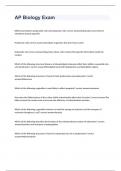
-
AP Biology Exam 2023/2024 with 100% complete solutions
- Exam (elaborations) • 25 pages • 2023
-
Available in package deal
-
- $16.49
- + learn more
Difference between prokaryotic cells and eukaryote cells: correct answersEukaryotes have internal-membrane bound organells Prokaryote cells correct answersUnicellular organisms that don't have nuclei Eukaryotic cells correct answersOrganisms whose cells contain their genetic information inside the nucleus Which of the following structural features of phospholipid molecules affect their ability to assemble into cell membranes? correct answersPhosolipids have both hydrophonic and hydroph...
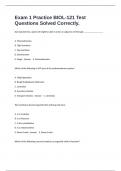
-
Exam 1 Practice BIOL-121 Test Questions Solved Correctly.
- Exam (elaborations) • 7 pages • 2024
-
Available in package deal
-
- $9.99
- + learn more
Dye injected into a plant cell might be able to enter an adjacent cell through _________________. A. Plasmodesmata B. Tight Junctions C. Gap Junctions D. Desmosomes E. Magic - Answer A. Plasmodesmata Which of the following is NOT part of the endomembrane system? A. Golgi Apparatus B. Rough Endoplasmic Reticulum C. Centrioles D. Secretory Vesicles E. Transport Vesicles - Answer C. Centrioles The membrane bound organelle that all living cells have. A. Is a nucleolus B...
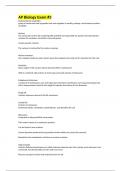
-
AP Biology Exam #3
- Exam (elaborations) • 6 pages • 2024
-
- $10.39
- + learn more
AP Biology Exam #3 Endomembrane organelles group of membranes and organelles that work together to modify, package, and transport proteins and lipids Nucleus The central part of the cell containing DNA and RNA and responsible for growth and reproduction - contains the nucleolus, chromatin, and nucleoplasm Contain genetic material The nucleus is enclosed by the nuclear envelope Nuclear envelope Has a double membrane and contains pores that regulate entry and exit of materials ...
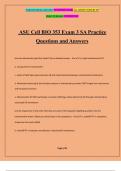
-
ASU Cell BIO 353 Exam 3 SA Practice Questions and Answers
- Exam (elaborations) • 16 pages • 2024
-
- $9.99
- + learn more
ASU Cell BIO 353 Exam 3 SA Practice Questions and Answers How do mitochondria get their lipids? Give a detailed answer. - Ans:-a. Lipids synthesized in ER b. transported to mitochondria c. switch of lipid takes place between ER and mitochondria & between mitochondrial membranes d. Membrane-tethering & lipid transfer proteins in mitochondria provides FIRST insight into mechanisms and transport processes e. Mitochondria DO NOT participate in vesicle trafficking, obtain lipids from ER throug...
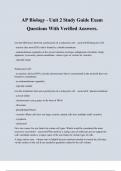
-
AP Biology - Unit 2 Study Guide Exam Questions With Verified Answers.
- Exam (elaborations) • 10 pages • 2024
-
- $12.49
- + learn more
AP Biology - Unit 2 Study Guide Exam Questions With Verified Answers. List the differences between a prokaryotic & a eukaryotic cell. - answerEukaryotic Cell: - nucleus (has more DNA) that's bound by a double membrane - endomembrane organelles in the cytosol (nuclear envelope, endoplasmic reticulum, Golgi apparatus, lysosomes, plasma membrane, various types of vesicles & vacuoles) - typically larger Prokaryotic Cell: - no nucleus, but has DNA (circular chromosome) that is concentrated i...
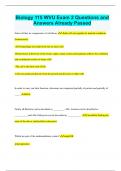
-
Biology 115 WVU Exam 2 Questions and Answers Already Passed
- Exam (elaborations) • 7 pages • 2024
-
Available in package deal
-
- $9.99
- + learn more
Biology 115 WVU Exam 2 Questions and Answers Already Passed Select all that are components of cell theory -Each cell can regulate its internal conditions (homeostasis) -All living things are made from one or more cells -Homeostasis at the level of the tissue, organ, organ system and organism reflects the combined and coordinated actions of many cells -The cell is the basic unit of life -Cells are produced directly from the growth and division of other cells In order to carry out t...
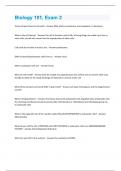
-
Biology 101, Exam 2 Questions And Answers.
- Exam (elaborations) • 11 pages • 2024
- Available in package deal
-
- $7.29
- + learn more
Three cell parts found in all cells? - Answer-DNA, plasma membrane, and cytoplasm or ribosomes What is the cell theory? - Answer-The cell is the basic unit of life, all living things are made up of one or more cells, and all cells come from the reproduction of other cells Cells that do not have a nucleus are: - Answer-prokaryotes DNA in bacterial/prokaryotic cells forms a: - Answer-circle DNA in eukaryotic cells are: - Answer-linear Why are cells small? - Answer-Cells do not get very large...

-
Test Bank for Biological Science Canadian Edition 2nd Edition by Scott Freeman, Michael Harrington, Joan C. Sharp
- Exam (elaborations) • 1121 pages • 2024
-
- $17.99
- + learn more
Test Bank for Biological Science, Canadian Edition 2nd Edition by Scott Freeman, Michael Harrington, Joan C. Sharp. Contents Chapter 1 Biology and the Tree of Life 1 1.1 The Cell Theory 2 Are All Organisms Made of Cells? 2 Where Do Cells Come From? 2 1.2 The Theory of Evolution by Natural Selection 4 What Is Evolution? 4 What Is Natural Selection? 4 1.3 The Tree of Life 5 Linnaean Taxonomy 6 BOX 1.1 Scientific Names and Terms 6 Using Molecules to Understand the Tree of Life 8 1.4 Doing Biology 1...
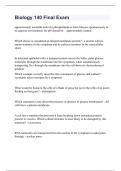
-
Biology 140 Final Exam
- Exam (elaborations) • 13 pages • 2024
-
- $13.49
- + learn more
approximately neutralIn order for phospholipids to form bilayers spontaneously in an aqueous environment, the pH should be: - approximately neutral Which choice is considered an integral membrane protein? - a protein with its amino-terminus in the cytoplasm and its carboxy-terminus in the extracellular space In intestinal epithelial cells, a transport protein moves the bulky, polar glucose molecules through the membrane into the cytoplasm, while simultaneously transporting Na+ through the ...
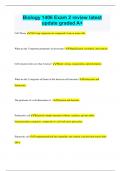
-
Biology 1406 Exam 2 review latest update graded A+
- Exam (elaborations) • 15 pages • 2024
- Available in package deal
-
- $9.99
- + learn more
Biology 1406 Exam 2 review latest update graded A+ Cell Theory All living organisms are composed of one or more cells. What are the 3 important parameters in microsopy? Magnification, resoultion, and contrast. Cell structure relies on what 4 factors? Matter, energy, organization, and information What are the 2 categories all forms of life based on cell structure? Prokaryotes and Eukaryotes. The proetome of a cell determines its ? Structure and function. Prokaryotic cell Rel...

How much did you already spend on Stuvia? Imagine there are plenty more of you out there paying for study notes, but this time YOU are the seller. Ka-ching! Discover all about earning on Stuvia


